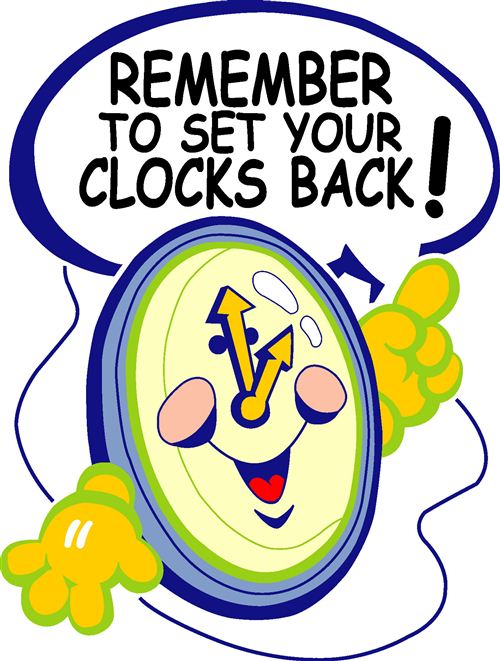History of Daylight Saving Time
While Daylight Saving Time wasn’t adopted in this country until the 20th century, it’s hardly a new idea. Several ancient civilizations used water clocks that were adjusted differently throughout the year.
In modern times, none other than Benjamin Franklin wrote an essay in 1784, “An Economical Project,” suggesting Daylight Saving Time as a way to save candles. The time shift finally happened in the U.S. in 1918 when President Woodrow Wilson signed it into law to help the war effort during World War I. Back then, it was called Fast Time. It was scrapped after the war. President Franklin D. Roosevelt brought it back in 1942 at the start of World War II. It’s been observed in this country ever since, and lengthened in recent years.
 This weekend we can sleep in an extra hour as we “fall back” into Standard Time and longer nights.
This weekend we can sleep in an extra hour as we “fall back” into Standard Time and longer nights.
Daylight Saving Time ends at 2 a.m. Sunday, Nov. 6, which means you’ll want to turn your old-school clocks back before you go to bed Saturday night, Nov. 5.
Of course, the change is automatic for most smartphones, computers, tablets and other digital devices. Daylight Saving Time — called daylight “savings” time by some — is the practice of setting the clocks forward one hour from standard time during the summer months, and back again in the fall, to make better use of natural daylight.
The good news for the early risers is sunrise will be about an hour earlier and there will be more light in the mornings, but it also means sunset will be around 5 p.m. depending on your location. The daylight will dwindle over the next two months as we head into winter. Sunset will be at 4:59 p.m. Sunday in Baltimore, 5:02 p.m. in Washington, DC, 5:40 p.m. in Atlanta, 4:46 p.m. in Nashville, and 5:42 p.m. in Tampa Bay.
Shorter days and the end of Daylight Saving Time are associated with SAD (seasonal affective disorder), a form of clinical depression that is believed to affect about 5 percent of the U.S. population; it may set in as people have less daylight to enjoy after they got off work. To combat the depression, the Mayo Clinic recommends outdoor activity, especially within two hours of awakening; exercising regularly; opening blinds and window shades to let light inside; light therapy; medications; and psychotherapy.
What will you do with your extra hour?
It is a good time to change smoke detector and carbon monoxide detector batteries and check to make sure those devices are in working order, according to fire officials.
Arizona, Puerto Rico, Hawaii, U.S. Virgin Islands and American Samoa do not observe daylight saving time.
Tips for Drivers, Pedestrians
The end to Daylight Saving Time means drivers should be prepared for sun glare during their morning commute, and again in the late afternoon.
“The morning sun may cause reflections off car windows, hoods or other metallic portions of automobiles and can be a serious hazard to drivers and pedestrians,” said Ragina C. Averella with AAA Mid-Atlantic.“Sun glare tends to be worse in the morning and in the late afternoon. The glare may cause temporary blindness.”
In 2014, the highest percentage, 25 percent, of weekday pedestrian fatalities nationwide occurred from 6 p.m. to 8:59 p.m., compared with the lowest percentage, 5 percent, in the morning, from 9 a.m. to 11:59 a.m.
In Maryland, nearly 50 percent of pedestrian fatalities occurred between 5 and 11 p.m., according to the Maryland Highway Safety Office.
“Pedestrians need to remember that motorists may not always see them at night as well as in the morning and late afternoon as motorists fight sun glare. Pedestrians need to do their part by practicing safety guidelines that will help ensure motorists can see them,” added Averella.
AAA Night-Time Driving Tips For Motorists
- Keep headlights, tail lights, signal lights, and windows (inside and out) clean.
- Have your headlights properly aimed. If not properly aimed, headlights will blind other drivers and reduce your ability to see the road.
- If there is any doubt, turn your headlights on. Lights will not help you see better in early twilight, but they’ll make it easier for other drivers to see you.
- Reduce your speed and increase your following distances. It is more difficult to judge other vehicles’ speeds and distances at night.
- When following another vehicle, keep your headlights on low beams so you don’t blind the driver ahead of you.
- If an oncoming vehicle doesn’t lower beams from high to low, avoid glare by watching the right edge of the road and using it as a steering guide.
AAA Pedestrian Safety Tips
- Cross only at intersections or crosswalks and not in the middle of the street or between parked cars.
- Stop at the curb and look left, right, and left again before you step into the street. Evaluate the distance and speed of oncoming traffic before you step out into the street.
- Avoid walking in traffic where there are no sidewalks or crosswalks. If you have to walk on a road that does not have sidewalks, walk facing traffic.
- Wear bright colors or reflective clothing if you are walking near traffic at night. Carry a flashlight when walking in the dark.
- Do not let umbrellas or jacket hoods block your view of approaching traffic.
- While walking, pocket the cell phone and turn down your music player so you can hear approaching vehicles.